Turnstiles fencing: their types and features of use
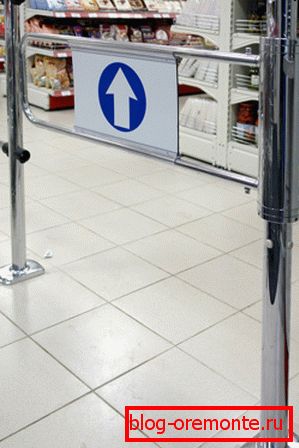
Turnstile installed in the supermarket.
The main purpose of the turnstile is to control the flow of people. Most often such constructions are installed:
- in the territories of administrative institutions;
- in industrial enterprises;
- In the underground;
- airports;
- banks;
- at train stations;
- as well as in supermarkets.
Today there is a wide variety of design options and design features of turnstiles. We will talk about them in this article.
Modern fences with turnstiles
While the turnstile barriers differ little from each other and are represented by chrome-plated tubular barriers, the crossing structures themselves are divided into several types.
According to the functionality of barrier fences are distinguished:
- Electromechanical turnstile. Such devices confidently keep up with the times, being worthy representatives of modern electronic equipment. Their main advantage is distance and autonomy. Such access systems are controlled either by a security officer by means of a console, or work as part of an access control system.
In the second case, the operation of the system is based on the presence of gaps. That is, in order to pass through the turnstile, it is necessary to bring the electronic pass to the reader, as a result of which the access controller decides whether to pass the identifier to the territory or not.
Such automation of the system becomes its disadvantage in the event of a breakdown. After all, to fix such a complex apparatus with your own hands no instruction will help you, and here you will have to call the wizard.

Electromechanical tripod.
- Mechanical. The gates of the fence in this case are opened by a person passing through them. No automation is provided. Reliability, unpretentiousness in operation and price stand out from the advantages of such structures.
Types of turnstiles
Depending on the design features, there are several types of turnstiles.
Tripods
One of the newest and most common mechanisms is the tripod. It consists of three blocking rotating strips located at an angle of 120 degrees to each other. One of the bars is always blocked passage.
Can be equipped with electric drive. In this case, it is an electromechanical device, driven by a small engine that responds to pressure. That is, in order to pass, you should slightly push the barrier bar, after which the tripod will smoothly turn through the electric drive.
The main advantages of such structures is their small size and price. The main disadvantage is the low level of protection of the protected object. So, the tripod can be easily passed by jumping over or crawling under the blocking bar, so installing a serious turnstile fence in this case does not make sense.
Tip! Such structures should be installed in places where there is additional protection, since they cannot create a significant barrier.
Depending on the design, tripods are:
- Hingedthat are fixed on the wall. They are very compact, and therefore are an excellent solution for limited spaces (for example, for buses).
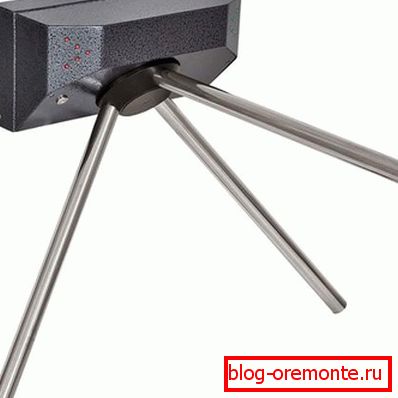
Hinged tripod.
- Stationary. Represent a cabinet that attaches directly to the floor.
- Single-bed, mounted on the same rack.
- Dvukhtumbovy, have two legs, in between which the blades are located.
Gate
Kalika is a swing barrier construction. In its simplest form, it is represented by the bar whether a barbell, which should simply be pushed by hand for the passage. Wickets are of the following types:
- Mechanical. A mechanical or electromechanical device is built into such structures, which smoothly and silently returns the arc to its original position. Most often, such devices can be found in supermarkets, where mechanical gates and low fencing for turnstiles are installed.
Such devices are installed to control the flow of people, they are not designed to block movement.
- Electromechanical with closer. Controlled by remote control or access control system. The ideal solution for access systems using plastic cards. Modern electromechanical gates can work with any access control system.
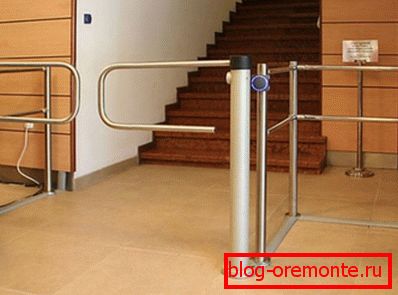
Electromechanical gate.
- With electric drive. Controlled by remote control or access control system. Such wickets not only close automatically, but also open. Depending on the setting, the normal position of such a mechanism can be both closed and open sash, which are closed in case of an unauthorized access attempt.
Speed turnstiles
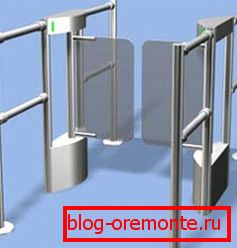
High speed turnstile.
Another name for this design is motorized walkways. They are able to provide the greatest throughput. They can have a design with high doors or small doors, while providing an increased degree of protection. Accordingly, the fence for the turnstile of this type should be above the belt of an adult. Models with retractable doors are installed, in particular, at metro stations.
Most of these structures operate in the “permanently open” mode, closing only when an unauthorized passage attempt is present. It is thanks to this mode of operation that these turnstiles are called speed, because they have a really large bandwidth (see also the article “Stair railings - style and safety”).
Rotary turnstiles
Such designs are of two types:
- Semi-profile (in the people - "spinner"). They are able to provide a greater degree of security than the gate and tripod, because they are installed mainly on more “serious” objects. Such a turnstile is a meter-high construction, which has three or four blades fixed along a vertical rotating axis. The blades can be solid or have the form of horizontal tubes.
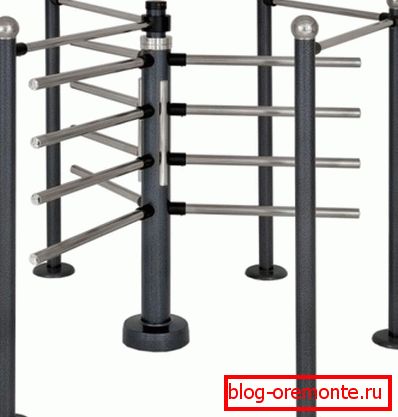
Photo of the rotor semi-turnstile.
- Full profile. Such systems are able to provide the maximum degree of security. Such designs reach a height of two to two and a half meters, and it is simply impossible to get around them. This is a real turnstile fence, which completely prevents unauthorized attempts to enter the territory.
Such structures can have a very complex structure, equipped with a metal detector, code set, weight panel, reinforced blocker. Their main drawback is a small bandwidth (about 10 people per minute), moreover, it is difficult to pass through such structures with large objects.
Conclusion
As you can see, access systems are divided into types depending on the required level of security. They also have different dimensions and design features, thanks to which you can determine the most suitable option. And in the presented video in this article you will find additional information on this topic (read also the article “Road barriers of barrier type: purpose and types”).